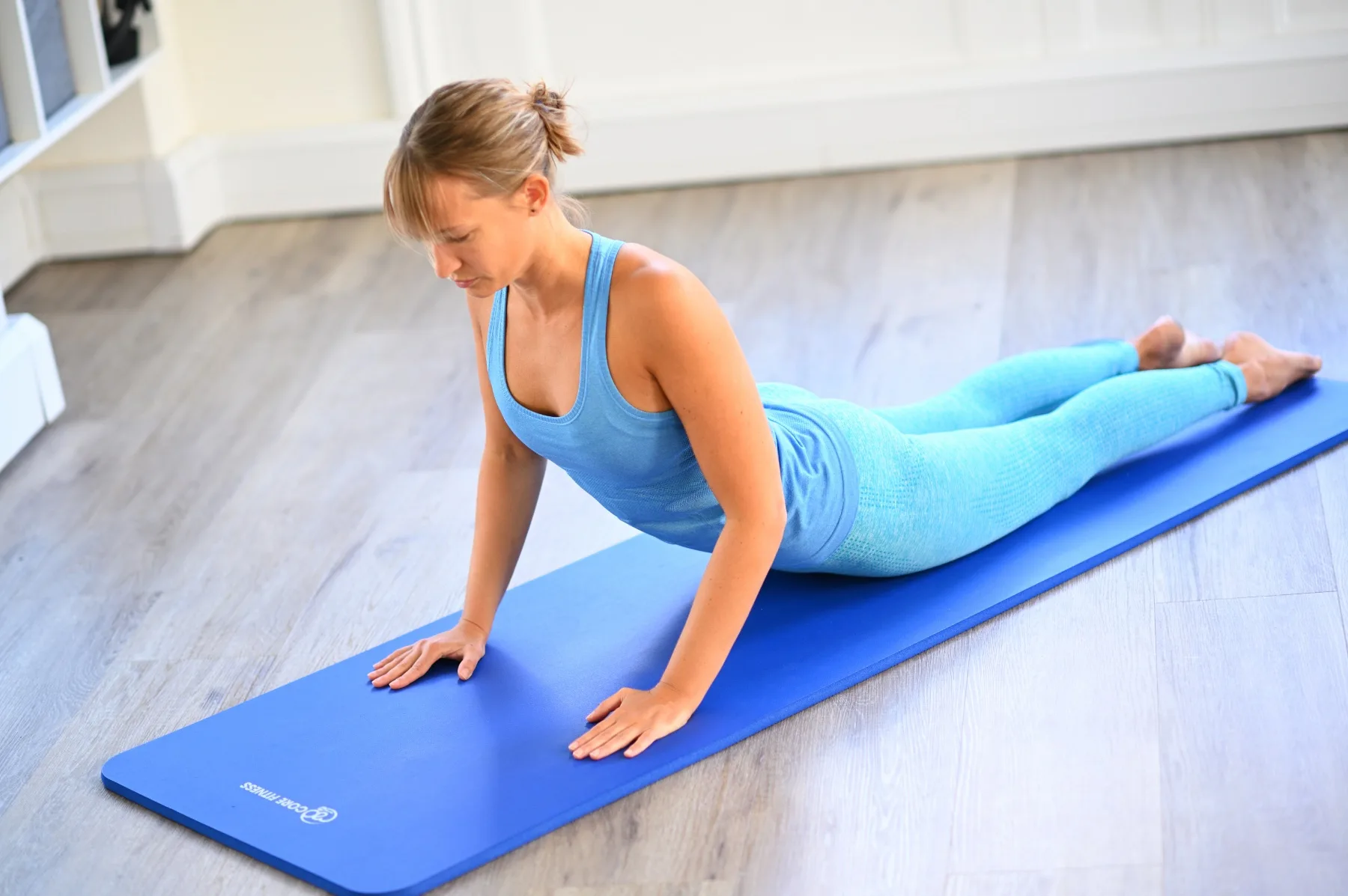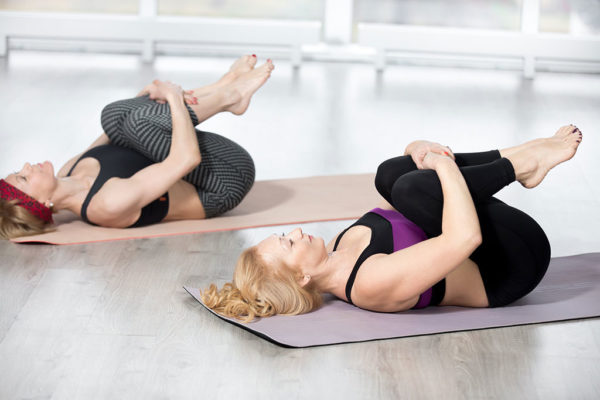Key Contributor: Susie Martin, Chartered Physiotherapist
Have you been diagnosed with spondylolisthesis? Have you been told to try Pilates to manage spondylolisthesis? Are you wondering whether Pilates will help? Want to know more about spondylolisthesis?
Read on to find out more about the role of Pilates in the treatment of spondylolisthesis.
Quick Summary
- Understanding Spondylolisthesis: Spondylolisthesis is a spinal condition where one vertebra slides over another, commonly occurring in the lower back (L4/5 and L5/S1).
- Causes include degenerative changes, sports activities involving back bending, trauma, or underlying medical conditions. Symptoms range from mechanical back pain to nerve pain, pins and needles, numbness, and less commonly weakness in the legs.
- Pilates enhances dynamic stability by strengthening torso muscles, thus compensating for any lack of stability in the spine due to spondylolisthesis. It is low-intensity, easily controlled, targets the whole body, and can be gradually progressed, making it suitable for individuals with this condition.
- Suitable Pilates exercises include Dead Bugs, Femur Arcs, Chest Lift, Side Lift, Dart, and Superman. Stretches like hamstring, gluteal, quadriceps, and knee hugs are also beneficial. Avoid deep back-bending movements.
What is spondylolisthesis?
Spondylolisthesis is a spinal condition, where you get movement of one segment of the spine (vertebra) on top of the other. Most commonly the vertebra slides slightly forwards, although backwards movement can also occur (known as a ‘retrolisthesis’). Spondylolisthesis is most common at the lowest segments of your lower back (known as L4/5 and L5/S1).
Finding out you have been diagnosed with this condition can be worrying, however, it is a surprisingly common condition and most cases are not serious. Mild spondylolisthesis may not even cause any symptoms or problems! This is because the human body is very adept at compensating and adapting for most issues. Because of this, you may have a spondylolisthesis and not even know it.
How can Pilates help with spondylolisthesis?
Generally, the spine is a very strong structure. Each vertebra is strongly attached to the intervertebral disc above and below and thick, fibrous ligaments span the length of the spinal column both internally and externally. This structure provides the spine with a lot of inherent strength and stability.
However, the intervertebral discs and ligaments are not the only structures that create strength and stability in the spine. The many muscles of the torso also provide a type of stability known as dynamic stability, which helps to protect the spine. In addition to the muscles working, the spine is also protected by the normal pressure inside the abdomen which is provided by the muscles of the diaphragm, pelvic floor and deep abdominal muscles all working in co-ordination with each other. As the diaphragm is a muscle of breathing, your breathing pattern can influence the harmonious working of all the muscles that support the spine and pelvis.
Pilates exercises target the dynamic stability of the spine extremely well. It is generally accepted that by strengthening the muscles of the torso you can compensate for any loss of stability in the spine caused by the spondylolisthesis.
Pilates is suitable for treating spondylolisthesis, not only because of its focus on the muscles that support the spine but for the following additional reasons.
- It is low intensity exercise – if you are not used to exercising or get pain with impact, then low intensity exercise can be more easily tolerated.
- Pilates exercises can be very simple – this makes it easy to maintain control over the speed, intensity and workload.
- Pilates exercises target the whole body – the appropriate exercises can be selected and tailored exactly to the individual’s needs
- Pilates exercises can be gradually progressed – this means you can see improvements in your strength and the exercises changed accordingly, so that you do not stay stuck at the same level.
Pilates is not the only exercise that you can do that will support your spine. Whole body strengthening in general helps to improve your torso strength. Exercises such as squats and lunges also produce activity in the muscles of your torso. However, it is important to consult with a medical professional or fitness professional who has experience of working with your condition to make sure you are doing such exercises with appropriate technique and load.
You can find out more about Pilates by reading our articles What is Pilates? and What to expect from a Pilates class.
What are the best Pilates exercises for someone with a spondylolisthesis?
The best programme is one that is tailored to your individual needs after a thorough assessment. Supervision whilst you are learning the exercises is more likely to ensure you are doing them effectively.
A good exercise programme will also contain exercises working the arms and legs that you do in standing; however, the following are the more classic mat-based Pilates exercises that are easy to do at home.
The following exercises are generally suitable for someone with a mild spondylolisthesis. However, if you get any pain doing these then ask for help before continuing.
Dead Bugs
Femur Arcs
Femur arcs are a progression of Dead Bugs
Chest Lift
Side Lift
Superman (Quadruped)
What are the best stretches for spondylolisthesis?
Scroll down to see some appropriate stretches for spondylolisthesis. Do remember that a one size fits all approach is not true of exercises so pay attention to any feelings of discomfort you have whilst doing these. Do not continue these exercises if they are exacerbating symptoms.
Aim to hold for up to 30 seconds depending on your tolerance and repeat 3 times on each side.
Supine hamstring stretch
Gluteal stretch
Quadriceps stretch
Knee hugs
Pilates exercises to avoid with spondylolisthesis
This type of deep back bend is not suitable for people with a spondylolisthesis.

What do our experts say?
I find Pilates is a brilliant tool for helping those with spondylolisthesis. It can be really daunting for people to receive a scary sounding diagnosis like this and so it is really rewarding to be able to help them realise there is so much they can do to help the pain and lead a normal life.
Frequently Asked Questions
How common is spondylolisthesis?
It is difficult to know the true prevalence of this condition since it does not always cause pain or problems. In one study, up to 18% of adults having an MRI scan were shown to have a spondylolisthesis. In another, 20.7% of a population who were being studied for the Framingham Heart Study were found to have a spondylolisthesis when their x-rays were reviewed. In this study group, there was no strong association between having low back pain and spondylolisthesis, which can also be translated into everyday life.
How is spondylolisthesis diagnosed?
Spondylolisthesis is diagnosed on the basis of medical imaging and can be detected on x-ray or CT scan. It can also be detected on MRI scan.
Spondylolisthesis is graded into four categories depending on the degree of severity. Seventy-five percent of spondylolisthesis diagnosed fall into the least significant category. A higher grade spondylolisthesis is more likely to cause symptoms or translate into problems with your normal day-to-day activities. Severe spondylolistheses are rare but often require an opinion from a consultant to discuss whether surgical treatment is needed.
Why does spondylolisthesis cause pain?
Spondylolisthesis may be associated with mechanical irritation of the spinal joints and it can also come from irritation or compression of the spinal nerve roots or spinal cord. This can lead to pain which has different qualities from mechanical pain. Pain from the nerve is often described as burning, aching or shooting pains. The pain often travels down the legs, sometimes into the feet. It is usually unrelated to movement and can get worse at night.
Spondylolisthesis can occasionally cause other nerve related symptoms such as pins and needles, numbness or tingling in the legs and feet.
Spondylolisthesis can also cause simple low grade back pain which doesn’t improve. It is always recommended that if you are getting lower back pain you speak to a physio or your GP to get an assessment. This will help provide you with a plan on how to improve.
What causes spondylolisthesis?
There are a few different causes of spondylolisthesis. ‘Degenerative’ changes to the joints and intervertebral discs may slowly cause symptoms over a long period of time and are more common in older people.
In younger people, spondylolisthesis is more commonly associated with activity and is associated with sports that require lots of back bending such as gymnastics and football. Spondylolisthesis can also happen following a physical trauma and very occasionally, it may be related to an underlying medical condition.
It is important that you are fully assessed by a medical professional in order to get the full picture of your condition. This means they can rule out any serious conditions such as infections or fractures and determine the most appropriate management of the condition for you.
Why is spondylolisthesis such a long word?
The word spondylolisthesis comes from the Greek words ‘spondylo’ meaning vertebra and ‘olisthesis’ meaning slide so the name refers to where one vertebra slides forwards on another one underneath.
Is there anything I should avoid doing with a spondylolisthesis?
Most exercises are safe for you but it is generally advised that you avoid movements where you bend the back to the limits of your range. For example – cobra type exercises, back to forward bends on the ladder barrel or a gymnastics bridge.
Can Complete Pilates help with spondylolisthesis?
We are a group of experienced Physiotherapists and Clinical Pilates instructors with a wealthof knowledge about spinal conditions. Interested in finding out more about whether we can help you? Get in touch!
Come into one of our Pilates studios in London tospeak to us about your condition and discover how Pilates can help. You can find us at our Pilates studio in Islington or any of our studios (see our Kensington Pilates studio or Complete Pilates City of London) for more information, please get in touch online or contact us on 0203 764 5668.
Get in touch with us via email or contact us on 0203 764 5668 for further information.
Resources
Education is key:
These blogs are designed to give information to everyone, however, it is important to remember that everyone is different! If you have not seen one of our therapists and have any questions about injuries, what you have read or whether this may be useful to you, please just ask. We are more than happy to help anyone and point you in the right direction. Our biggest belief is that education is key. The more you understand about your injury, illness and movement, the more you are likely to improve.










